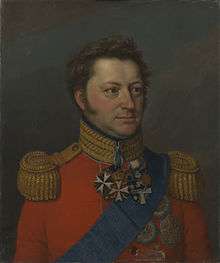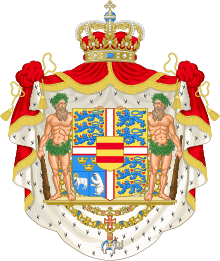Princess Juliane Sophie of Denmark
| Juliane Sophie of Denmark | |
|---|---|
| Princess William of Hesse-Philippsthal-Barchfeld | |
 | |
| Born |
18 February 1788 Copenhagen, Denmark-Norway |
| Died |
9 May 1850 (aged 62) Copenhagen, Denmark |
| Burial | Roskilde Cathedral |
| Spouse | Landgrave Wilhelm of Hesse-Philippsthal-Barchfeld |
| House | House of Oldenburg |
| Father | Hereditary Prince Frederick of Denmark and Norway |
| Mother | Sophia Frederica of Mecklenburg-Schwerin |
| Religion | Lutheranism |
Juliane Sophie (18 February 1788, in Copenhagen – 9 May 1850, in Copenhagen) was a Princess of Denmark, the daughter of Frederick, Hereditary Prince of Denmark, he himself a younger son of king Frederick V of Denmark in his second marriage to Juliana Maria of Braunschweig-Wolfenbüttel.
Family
Princess Juliane Sophie was the oldest daughter and second surviving child of Hereditary Prince Frederick and his wife Duchess Sophia Frederica of Mecklenburg-Schwerin, daughter of Duke Louis of Mecklenburg-Schwerin and Princess Charlotte Sophie of Saxe-Coburg-Saalfeld. Her siblings included the future Christian VIII of Denmark.
The actual paternity of Juliane Sophie and her siblings has been debated, and it is widely believed that the father of Sophia Frederica's children was Prince Frederick's adjutant, Frederik von Blücher.
When Juliane was born her uncle king Christian VII of Denmark was the reigning monarch, but the actual ruler was the Crown Prince, the future Frederick VI of Denmark.
A few years prior to her birth the control of the kingdom had been in the hands of her grandmother Queen Dowager Juliane Marie, whom she was named after, and her father, but a coup by the Crown Prince had deprived her family of the power.
Early years
For the first years of her life Juliane lived with the rest of the royal family at Christiansborg Palace, but after the palace was destroyed by fire in 1794, Hereditary Prince Frederick moved with his family to a mansion at Amalienborg Palace. Her mother, Sophia Frederica died the same year, shortly after the move.
When Juliane was a child there was still a lot of tension between the two branches of the royal family because of the coup, but eventually they made up.
In 1803, Juliane had her confirmation together with her brother Christian and sister, Princess Louise Charlotte of Denmark at the chapel at Frederiksberg Palace.
Marriage

On 22 August 1812, at Frederiksberg Palace, Juliane Sophie married Landgrave Wilhelm of Hesse-Philippsthal-Barchfeld, (Barchfeld, 10 August 1786 – Copenhagen, 30 November 1834). Wilhelm was the son of Adolph, Landgrave of Hesse-Philippsthal-Barchfeld and Princess Louise of Saxe-Meiningen.
Wilhelm lived in Denmark from an early age and had a successful military career, and was a popular and respected man in the Danish capital.
The marriage was happy and was founded on genuine feelings from both parties. The couple however didn't have any children, apparently because Juliane was afraid of dying in childbirth. Wilhelm instead had a mistress with whom he had five daughters.
Danish throne
During the years it became clear that the Danish throne would be inherited by her brother Christian. In 1821 she along with her branch of the royal family were elevated to the style of Royal Highness instead of Highness.
When Julianes childless nephew, Frederick VII of Denmark became king in 1848 she was second in-line to the throne after her childless brother, Ferdinand, Hereditary Prince of Denmark. However, there was already talks about securing the Danish Monarchy, which consisted of several states, by giving the throne to a person that could keep it together and Juliane accepted this.
Juliane died in 1850, shortly before the succession was settled on her sisters son-in-law, the future Christian IX of Denmark.
References
- Bo Bramsen: Ferdinand og Caroline : en beretning om prinsen der nødig ville være konge af Danmark, 1983 (in Danish).
- Dansk Biografisk Lexikon, First edition by C.F Bricka, http://runeberg.org/dbl/ (in Danish).
External links
![]() Media related to Princess Juliane Sophie of Denmark at Wikimedia Commons
Media related to Princess Juliane Sophie of Denmark at Wikimedia Commons
